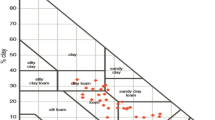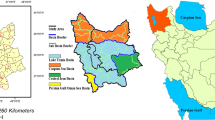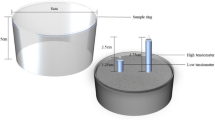Abstract
Direct measurement of the least limiting water range (LLWR) is costly and time-consuming. In this study, genetic algorithm-based neural network (ANN-GA), artificial neural network (ANN) and stepwise multivariate regression (SMR) were used to estimate the LLWR of soil using easily measurable soil properties in the Khanmirza Plain. Then, depending on the location of each area, a total of 250 points were randomly identified as approximate sampling sites. Results showed that the accuracy of the SMR model with the percentage of clay, organic carbon and fine sand had a coefficient of determination of 0.42. The ANN-GA and ANN models with the highest coefficient of determination (R2 = 0.98) and mean square error (MAE = 0.0538) were suitable for estimating the least limiting water range. Therefore, the efficiency of models showed that the ANN and ANN-GA predicted the LLWR more accurate compared to the SMR and their results were close to the measured ones.



Similar content being viewed by others
REFERENCES
M. Ajami, A. Heidari, F. Khormali, M. Gorji, and S. Ayoubi, “Environmental factors controlling soil organic carbon storage in loess soils of a subhumid region, northern Iran,” Geoderma 281, 1–10 (2016).
S. Amanabadi, M. Vazirinia, H. Vereecken, K. A. Vakilian, and M. H. Mohammadi, “Comparative study of statistical, numerical and machine learning-based pedotransfer functions of water retention curve with particle size distribution data,” Eurasian Soil Sci. 52, 1555–1571 (2019).
M. Annabi, S. Houot, C. Francou, M. Poitrenaud, and Y. Le Bissonnais, “Soil aggregate stability improvement with urban composts of different maturity levels,” Soil Sci. Soc. Am. J. 71, 413–423 (2007).
F. Asadzadeh, M. Maleki-Kakelar, and F. Shabani, “Predicting cationic exchange capacity in calcareous soils of East-Azerbaijan province, northwest Iran,” Commun. Soil Sci. Plant Anal. 50, 1106–1116 (2019).
H. Asgarzadeh, M. R. Mosaddeghi, A. A. Mahboubi, A. Nosrati, and A. R. Dexter, “Soil water availability for plants as quantified by conventional available water, least limiting water range and integral water capacity,” Plant Soil 335, 229–244 (2010).
S. Ayoubi, F. Khormali, K. L. Sahrawat, and A. C. R. De Lima, “Assessing impacts of land use change on soil quality indicators in a loessial soil in Golestan Province, Iran,” J. Agric. Sci. Technol. 13 (5), 727–742 (2011)
O. Bahmani and S. Palangi, “Evaluation of pedotransfer functions for estimating the soil water retention points,” Eurasian Soil Sci. 49, 652–660 (2016).
A. A. Basalatpour, PhD Thesis (Isfahan University of Technology, Isfahan, 2012).
H. Bayat, M. R. Neyshaburi, M. A. Hajabbasi, A. A. Mahboubi, and M. R. Mosaddeghi, “Comparing neural networks, linear and nonlinear regression techniques to model penetration resistance,” Turk. J. Agric. For. 32, 425–433 (2008).
H. Bayat, M.R. Neyshaburi, K. Mohammadi, N. Nariman-Zadeh, M. Irannejad, and A.S. Gregory, “Combination of artificial neural networks and fractal theory to predict soil water retention curve,” Comput. Electron. Agric. 92, 92–103 (2013).
A. Bazoobandi, S. Emamgholizadeh, and H. Ghorbani, “Estimating the amount of cadmium and lead in the polluted soil using artificial intelligence models,” Eur. J. Environ. Civ. Eng. 8, (2019).
A. A. Belik, A. G. Bolotov, E. V. Shein, A. A. Kokoreva, A. A. Levin, and V. Yu Patrushev, “Application of neural network pedotransfer functions to calculate soil water retention curve,” IOP Conf. Ser.: Earth Environ. Sci. 368, 012008 (2019).
A. N. Beutler, J. F. Centurion, A. P. da Silva, M. A. P. da Cruz Centurion, C. L. Leonel, and O. da Silva Freddi, “Soil compaction by machine traffic and least limiting water range related to soybean yield,” Pesqui. Agropecu. Bras. 43, 1591–1600 (2008).
R. Bhuvana, BSc Thesis (A.M. Jain College, Chennai, 2014).
G. R. Blake and K. H. Hartge, “Bulk density,” in Methods of Soil Analysis, Part 1: Physical and Mineralogical Methods, Ed. by A. Klute (American Society of Agronomy, Madison, WI, 1986), pp. 363–375.
Y.-D. Botula, A. Nemes, P. Mafuka, E. van Ranst, and W. M. Cornelis, “Prediction of water retention of soils from the humid tropics by the nonparametric k-nearest neighbor approach,” Vadose Zone J. 12, 1–17 (2013).
S. Ghorbani Dashtaki, M. Homaee, and H. Khodaverdiloo, “Derivation and validation of pedotransfer functions for estimating soil water retention curve using a variety of soil data,” Soil Use Manage. 26, 68–74 (2010).
S. Emamgholizadeh, K. Bahman, S. M. Bateni, H. Ghorbani, I. Marofpoor, and J. R. Nielson, “Estimation of soil dispersivity using soft computing approaches,” Neural Comput. Appl. 28, 207–216 (2017).
S. Emamgolizadeh, S. M. Bateni, D. Shahsavani, T. Ashrafi, and H. Ghorbani, “Estimation of soil cation exchange capacity using Genetic Expression Programming (GEP) and Multivariate Adaptive Regression Splines (MARS),” J. Hydrol. 529, 1590–1600 (2015).
G. Fenton, K. R. Helyar, T. Abbott, and P. Orchard, Soil Acidity and Liming: Agfact AC 19, 2nd ed. (NSW Agriculture, Orange, NSW, 1996).
H. Ghorbani, H. Kashi, N. Hafezi Moghadas, and S. Emamgholizadeh, “Estimation of soil cation exchange capacity using multiple regression, artificial neural networks and adaptive neuro-fuzzy inference system models in Golestan Province, Iran,” Commun. Soil Sci. Plant Anal. 46, 763–780 (2015).
H. Ghorbani, H. Kashi, N. Hafezi Moghadas, and S. Emamgholizadeh, “Estimation of soil cation exchange capacity using multiple regression, artificial neural networks and adaptive neuro-fuzzy inference system models in Golestan Province, Iran,” Commun. Soil Sci. Plant Anal. 46, 763–780 (2015).
M. Gunarathna and K. Sakai, “Evaluation of pedotransfer functions for estimating soil moisture constants: a study on soils in dry zone of tropical Sri Lanka,” Int. J. Adv. Sci. Eng. Technol. 6, 69–73 (2018).
Y. X. Hou, H. F. Zhao, Z. Zhang, and K. N. Wu, “A novel method for predicting cadmium concentration in rice grain using genetic algorithm and back-propagation neural network based on soil properties,” Environ. Sci. Pollut. Res. 25, 35682–35692 (2018).
A. K. Jain, J. Mao, and K. M. Mohiuddin, “Artificial neural networks: a tutorial,” IEEE Comput. Soc. J. 29, 31–44 (1996).
A. Johari, A. A. Javadi, and G. Habibagahi, “Modelling the mechanical behaviour of unsaturated soils using a genetic algorithm-based neural network,” Comput. Geotech. 38, 2–13 (2011).
M. Karamouz and S. Araghinejad, Advanced Hydrology (Industrial University of Amir Kabir, Tehran, 2005).
H. Kashi, S. Emamgholizadeh, and H. Ghorbani, “Estimation of soil infiltration and cation exchange capacity based on multiple regression, ANN (RBF, MLP), and ANFIS models,” Commun. Soil Sci. Plant Anal. 45, 1195–1213 (2014).
Z. Kazemi, M. R. Neyshabouri, H. Bayat, S. Oustan, and M. Moghaddam, “Performance of three models in predicting least limiting water range in soil,” Iran. J. Soil Res. 28, 659–699 (2015).
T. Keller, A. P. da Silva, C. A. Tormena, N. F. B. Giarola, K. M. V. Cavalieri, M. Stettler, and J. Arvidsson, “SoilFlex-LLWR: linking a soil compaction model with the least limiting water range concept,” Soil Use Manage. 31, 321–329 (2015).
B. Khalili Moghadam, M. Afyuni, A. Jalalian, K. C. Abbaspour, and A. A. Dehghani, “Estimation of soil saturated hydraulic conductivity in part of Central Zagroos using regression and ANNs method,” J. Sci. Technol. Agric. Nat. Resour. 19, 217–228 (2015).
H. Khodaverdiloo, M. Homaee, M. Th. van Genuchten, and S. G. Dashtaki, “Deriving and validating pedotransfer functions for some calcareous soils,” J. Hydrol. 399, 93–99 (2011).
J. R. Landon, Booker Tropical Soil Manual: A Handbook for Soil Survey and Agricultural Land Evaluation in the Tropics and Subtropics (Routledge, London, 2014).
S. H. M. Langroodi, M. G. Masoum, H. Nasiri, and S. T. Javi, “Spatial and temporal variability analysis of groundwater quantity to land-use/land-cover change in the Khanmirza agricultural plain in Iran,” Arab. J. Geosci. 8, 8385–8397 (2015).
S. Li, X. Wu, G. Liang, L. Gao, B. Wang, J. Lu, A. A. Abdelrhman, X. Song, M. Zhang, F. Zheng, and A. Degré, “Is least limiting water range a useful indicator of the impact of tillage management on maize yield?” Soil Tillage Res. 199, 104602 (2020).
R. P. D. Lima, T. Keller, N. B. F. Giarola, C. A. Tormena, A. R. D. Silva, and M. M. Rolim, “Measurements and simulations of compaction effects on the least limiting water range of a no-till oxisol,” Soil Res. 58, 62–72 (2019).
W. Liu, Q. Liu, F. Ruan, Z. Liang, and H. Qiu, “Springback prediction for sheet metal forming based on GA–ANN technology,” J. Mater. Process. Technol. 187–188, 227–231 (2007).
W. K. Mbarak, E. N. Cinicioglu, and O. Cinicioglu, “SPT based determination of undrained shear strength: regression models and machine learning,” Front. Struct. Civ. Eng. 14, 185–198 (2020).
R. Mirabbasi, O. Kisi, H. Sanikhani, and S. Gajbhiye Meshram, “Monthly long-term rainfall estimation in Central India using M5Tree, MARS, LSSVR, ANN and GEP models,” Neural Comput. Appl. 31, 6843–6862 (2019).
M. R. Mosaddeghi and A. A. Mahboubi, “Point pedotransfer functions for prediction of water retention of selected soil series in a semi-arid region of western Iran,” Arch. Agron. Soil Sci. 57, 327–342 (2011).
N. Jenadeleh, H. A. Nadian, B. Khalilimoghadam, and S. Ghorbani Dashtaki, “Point estimation of soil moisture characteristic curve using artificial neural networks and its optimizing by genetic algorithm in Agro-Industries of Khouzestan,” Watershed Manage. Res. 29 (4), 40–50 (2017).
D. W. Nelson and L. Sommers, “Total carbon, organic carbon, and organic matter,” in Methods of Soil Analysis, Part 2: Chemical and Microbiological Properties, Ed. by A. L. Page (American Society of Agronomy, Soil Science Society of America, Madison, WI, 1982), Chap. 29, p. 539.
A. Nemes, W.J. Rawls, and Y. A. Pachepsky, “Influence of organic matter on the estimation of saturated hydraulic conductivity,” Soil Sci. Soc. Am. J. 69, 1330–1337 (2005).
H. Nezamabadi-pour, Genetic Algorithm: Basic Concepts and Advanced Topics (Shahid Bahonar University Press, Kerman, 2010).
I. Nehmi de Oliveira, Z. Menezes de Souza, L. H. Lovera, C. V. Vieira Farhate, E. De Souza Lima, D. A. Aguilera Esteban, and J. A. Fracarolli, “Least limiting water range as influenced by tillage and cover crop,” Agric. Water Manage. 225, 105777 (2019).
K. Parasuraman, A. Elshorbagy, and B. C. Si, “Estimating saturated hydraulic conductivity in spatially variable fields using neural network ensembles,” Soil Sci. Soc. Am. J. 70, 1851–1859 (2006).
H. Sanikhani, R. C. Deo, Z. M. Yaseen, O. Eray, and O. Kisi, “Non-tuned data intelligent model for soil temperature estimation: a new approach,” Geoderma 330, 52–64 (2018).
M. G. Schaap, F. J. Leij, and M. Th. van Genuchten, “Neural network analysis for hierarchical prediction of soil hydraulic properties,” Soil Sci. Soc. Am. J. 62, 847–855 (1998).
A. P. da Silva, B. D. Kay, and E. Perfect, “Characterization of the least limiting water range of soils,” Soil Sci. Soc. Am. J. 58, 1775–1781 (1994).
A. P. da Silva and B. D. Kay, “Estimating the least limiting water range of soils from properties and management,” Soil Sci. Soc. Am. J. 61, 877–883 (1997).
O. Sivrikaya, “Comparison of Artificial Neural Networks models with correlative works on undrained shear strength,” Eurasian Soil Sci. 42, 1487–1496 (2009).
J. Skalová, M. Čistý, and J. Bezák, “Comparison of three regression models for determining water retention curves,” J. Hydrol. Hydromech. 59, 275 (2011).
Stepwise linear regression. http://www.geog.leeds. ac.uk/courses/other/statistics/spss/stepwise. Accessed March 3, 2020.
R. Taghizadeh-Mehrjardi, S. Ayoubi, Z. Namazi, B. P. Malone, A. A. Zolfaghari, and F. R. Sadrabadi, “Prediction of soil surface salinity in arid region of central Iran using auxiliary variables and genetic programming,” Arid Land Res. Manage. 30, 49–64 (2016).
R. Taghizadeh-Mehrjardi, “Digital mapping of cation exchange capacity using genetic programming and soil depth functions in Baneh region, Iran,” Arch. Agron. Soil Sci. 62, 109–126 (2016).
S. Taşan and Y. Demir, “Comparative analysis of MLR, ANN, and ANFIS models for prediction of field capacity and permanent wilting point for Bafra plain soils,” Commun. Soil Sci. Plant Anal. 51 (1), 1–18 (2020).
M. Mahbobi and T. K. Tiemann, Introductory Business Statistics with Interactive Spreadsheets, 1st ed. (BCcampus, Victoria, BC, 2010).
C. A. Tormena, D. L. Karlen, S. Logsdon, and M. R. Cherubin, “Corn stover harvest and tillage impacts on near-surface soil physical quality,” Soil Tillage Res. 166, 122–130 (2017).
M. G. Wilson, M. C. Sasal, and O. P. Caviglia, “Critical bulk density for a Mollisol and a Vertisol using least limiting water range: effect on early wheat growth,” Geoderma 192, 354–361 (2013).
Z. M. Yaseen, I. Ebtehaj, S. Kim, H. Sanikhani, H. Asadi, M. I. Ghareb, H. Bonakdari, W. H. M. Wan Mohtar, N. Al-Ansari, and S. Shahid, “Novel hybrid data-intelligence model for forecasting monthly rainfall with uncertainty analysis,” Water 11, (2019).
B. Yegnanarayana, Artificial Neural Networks (Prentice-Hall, New Delhi, 2009).
M. Zangiabadi, M. Gorji, M. Shorafa, S. Khavarikhorasani, and S. Saadat, “Effect of soil pore size distribution on plant-available water and least limiting water range as soil physical quality indicators,” Pedosphere 30, 253–262 (2020).
Author information
Authors and Affiliations
Corresponding author
Rights and permissions
About this article
Cite this article
Soleimani, R., Chavoshi, E., Shirani, H. et al. Evaluation of Intelligence Models to Estimate the Least Limiting Water Range Using Conveniently Measurable Soil Properties. Eurasian Soil Sc. 54, 389–398 (2021). https://doi.org/10.1134/S1064229321030145
Received:
Revised:
Accepted:
Published:
Issue Date:
DOI: https://doi.org/10.1134/S1064229321030145




